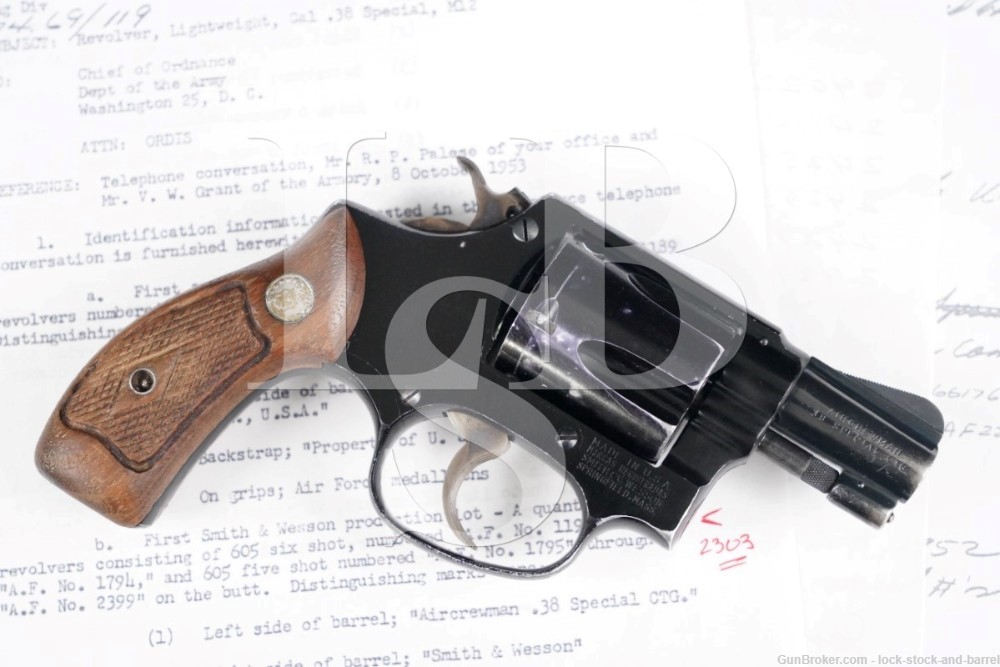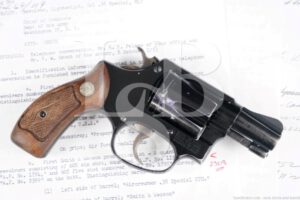
USAF Smith & Wesson S&W Model Baby Aircrewman .38 Spl 2″ Revolver C&R
Sold For: $6,950.00
LSB#: 220307KW020
Make: Smith & Wesson
Model: Baby Aircrewman
Serial Number: 2303
Year of Manufacture: Ca. 1952
Caliber: .38 Special
Action Type: 5-Shot Double / Single Action, Swing-Out Fluted Cylinder Revolver
Markings: The right side of the barrel is marked “AIRCREWMAN / 38 SPECIAL CTG.”, the left is marked “SMITH & WESSON”. The left side of the frame has S&W’s monogram logo, the right side of the frame is marked with the four line Marcas Registradas. The yoke and yoke cut have inspection marks. The sides of the grip frame have inspection marks. The butt of the grip frame is marked “A.F. No. 2303”. The backstrap is marked “PROPERTY OF U.S. AIR FORCE”. The rear face of the cylinder, rear face of the yoke, front face of the ejector, and barrel flat are matched to the revolver and marked with the serial number “2303”. The left side of the frame is marked “P” at the yoke. The grips do not have any markings.
Barrel Length: 2?
Sights / Optics: The front sight is a serrated ramped blade integral to the barrel. The rear sight is a square notch at the rear of the top strap.
Stock Configuration & Condition: The grips are checkered walnut magna stocks with Air Force medallions and smooth diamonds around the grip screws. The wood has weathering and the majority of the finish has been lost. There is wear on the edges that border the checkering. There are some scattered little scuffs and one or two faint compressions. The checkering has wear but is still well defined. The grips rate in about Very Good overall condition.
Type of Finish: Black Alloy with Blued Steel Barrel & Yoke
Finish Originality: Original
Bore Condition: The bore is bright and the rifling is sharp. There is no erosion in the bore.
Overall Condition: This handgun retains about 80% of its metal finish. There is finish wear on the edges, most noticeable on the front edges of the frame, cylinder, and trigger guard. There are scattered scuffs that have thinned the finish, most noticeable on the cylinder and topstrap. There are some little nicks and scratches. There is finish loss on the barrel at the muzzle. There are some spots of light surface oxidation and some faint discoloration on the barrel. There are some light scrapes on the edges of the trigger guard. The screw heads are sharp to tool marked, the heaviest worn screw is the grip screw. The markings are clear. Overall, this handgun rates in about Very Good condition.
Mechanics: Due to the alloy construction of the cylinder, we do not recommend shooting this revolver…neither does Smith & Wesson. The action functions correctly with light side-to-side play in lockup. We did not fire this handgun. As with all used firearms, a thorough cleaning may be necessary to meet your maintenance standards.
Box, Paperwork & Accessories: Included is a photocopy of an Ordnance Corps Springfield Armory detailing features of the Baby Aircrewman.
Our Assessment: When the Korean War started in 1950, the US Air Force put out a call for lightweight, compact personal defense weapons they could issue to aircrews. Colt and Smith & Wesson, two of the largest and oldest revolver manufacturers, both submitted prototypes that used aluminum alloys in their designs. Fun Fact: While a common material today, aluminum was almost exclusively used in prototypes and one-off firearms prior to the 1950s. Oliver Winchester built a prototype shotgun with aluminum receiver plates as early as 1865, but the cost to purify and process aluminum was prohibitive back then. The Air Force would adopt Smith & Wesson’s design and ordered over 40,000 of the Pre-Model 12-style lightweight six shooters in .38 Special but there was also a 5-shot Aircrewman which resembled the Pre-Model 37. The smaller five-shot revovler is dubbed the “Baby Aircrewman” due to its smaller size and is much rarer than its bigger brother with only 605 produced. These revolvers would arm aircrewmen as well as agents in the Office of Special Investigations. Unfortunately, the aluminum alloy that was so cutting edge and lightweight that it helped Smith & Wesson win the Air Force contract was this product’s ultimate undoing. By 1959, many of the aluminum cylinders and frames of these revolvers showed significant breaks, cracks, and weaknesses, some units having ruptured altogether. The Smith & Wesson Aircrewmen revolvers, which require the low-pressure M41 Special Ball ammunition as they couldn’t withstand commercial ammo loaded with lead bullets, was scraped (literally, in most cases). But these guns were the beginning of a revolution in gun materials, and this revolver and its accessories showcase that history perfectly. This particular revolver comes from the collection of author Kevin Williams, best known for his work on the topic of General Officers Pistols & Clandestine Organization Pistols of WWII. This Baby Aircrewman is serial number 2303, the Springfield Armory Ordnance Corps letter that accompanies this gun states that this serial number would fall within the serial range of A.F. No. 1795 to A.F. No. 2399. The letter also lists features of the Baby Aircrewman such has barrel markings and backstrap markings which match on this revolver. Whether you’re a general firearms collector, military historian, or specifically a Smith & Wesson fan, this revolver would improve any collection it joined. Please see our photos and good luck!

